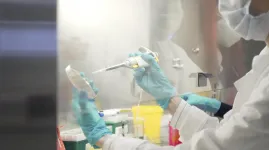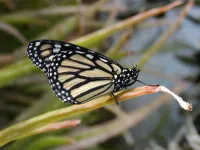(Press-News.org) AMES, Iowa - Wind turbine blades spinning through cold, wet conditions can collect ice nearly a foot thick on the yard-wide tips of their blades.
That disrupts blade aerodynamics. That disrupts the balance of the entire turbine. And that can disrupt energy production by up to 80 percent, according to a recently published field study led by Hui Hu, Iowa State University's Martin C. Jischke Professor in Aerospace Engineering and director of the university's Aircraft Icing Physics and Anti-/De-icing Technology Laboratory.
Hu has been doing laboratory studies of turbine-blade icing for about 10 years, including performing experiments in the unique ISU Icing Research Tunnel. Much of that work has been supported by grants from the Iowa Energy Center and the National Science Foundation.
"But we always have questions about whether what we do in the lab represents what happens in the field," Hu said. "What happens over the blade surfaces of large, utility-scale wind turbines?"
We all know about one thing that recently happened in the field. Wind power and other energy sources froze and failed in Texas during last month's winter storm.
Searching for a field site
Hu wanted to quantify what happens on wind farms during winter weather and so several years ago began organizing a field study. But that was more complicated than he expected. Even in Iowa, where some 5,100 wind turbines produce more than 40% of the state's electricity (according to the U.S. Energy Information Association), he wasn't given access to turbines. Energy companies usually don't want their turbine performance data to go public.
So Hu - who had made connections with researchers at the School of Renewable Energy at North China Electric Power University in Beijing as part of an International Research Experiences for Students program funded by the National Science Foundation - asked if Chinese wind farms would cooperate.
Operators of a 34-turbine, 50-megawatt wind farm on a mountain ridgetop in eastern China agreed to a field study in January 2019. Hu said most of the turbines generate 1.5 megawatts of electricity and are very similar to the utility-scale turbines that operate in the United States.
Because the wind farm the researchers studied is not far from the East China Sea, Hu said the wind turbines there face icing conditions more like those in Texas than in Iowa. Iowa wind farms are exposed to colder, drier winter conditions; when winter cold drops to Texas, wind farms there are exposed to more moisture because of the nearby Gulf of Mexico.
Measuring the ice
As part of their field work, the researchers used drones to take photos of 50-meter-long turbine blades after exposure to up to 30 hours of icy winter conditions, including freezing rain, freezing drizzle, wet snow and freezing fog.
The photographs allowed detailed measurement and analyses of how and where ice collected on the turbine blades. Hu said the photos also allowed researchers to compare natural icing to laboratory icing and largely validated their experimental findings, theories and predictions.
The photos showed, "While ice accreted over entire blade spans, more ice was found to accrete on outboard blades with the ice thickness reaching up to 0.3 meters (nearly 1 foot) near the blade tips," the researchers wrote in a paper recently published online by the journal Renewable Energy. (See sidebar for the full research team.)
The researchers used the turbines' built-in control and data-acquisition systems to compare operation status and power production with ice on the blades against more typical, ice-free conditions.
"That tells us what's the big deal, what's the effect on power production," Hu said.
The researchers found that icing had a major effect:
"Despite the high wind, iced wind turbines were found to rotate much slower and even shut down frequently during the icing event, with the icing-induced power loss being up to 80%," the researchers wrote.
That means Hu will continue to work on another area of wind-turbine research - finding effective ways to de-ice the blades so they keep spinning, and the electricity keeps flowing, all winter long.
INFORMATION:
The research team
Hui Hu of aerospace engineering led the field study of ice buildup on wind turbine blades. Other researchers and co-authors are:
Linyue Gao, an Iowa State graduate with a doctorate in aerospace engineering who's now a postdoctoral associate at the St. Anthony Falls Laboratory of the University of Minnesota
Tao Tao, a graduate student at the School of Renewable Energy at North China Electric Power University in Beijing
Yongqian Liu, a professor at the School of Renewable Energy at North China Electric Power University in Beijing
Read the paper
"A field study of ice accretion and its effects on the power production of utility-scale wind turbines," Renewable Energy, Volume 167 (April 2021), https://doi.org/10.1016/j.renene.2020.12.014
HOUSTON - (March 4, 2021) - Federal and state governments auction leases to oil and gas companies to extract natural resources from public land. A revamp of the auction system -- utilizing a new model developed by a Rice University economist -- could lead to more competitive bids and, ultimately, more money for governments.
Yunmi Kong, an assistant professor of economics at Rice and the study's author, discussed her model in "Sequential Auctions with Synergy and Affiliation Across Auctions." The article appeared in the January 2021 edition of the Journal of Political Economy.
"Much of the oil- and gas-producing ...
Scientists from Skoltech and MSU have investigated antibiotic nybomycin that could prove effective against bacteria resistant to other antibiotics. Their research was published in the journal Antimicrobial Agents and Chemotherapy.
All bacterial cells contain topoisomerases, an important group of enzymes that help deal with spatial difficulties stemming from bacterial cell division associated with circular DNA replication. Topoisomerases can be of two types, I and II, depending on breaks they produce in DNA (one strand or double strand). Type II often acts as a target for antibiotics, including fluoroquinolones (FQ), a common group of antibiotics that comprises levofloxacin, ciprofloxacin, and others. Unfortunately, bacteria easily acquire resistance to ...
Managing single risk factors like blood pressure rather than looking at overall risk may be wasting scarce resources in countries where cardiovascular disease (CVD) is on the rise, according to a new study.
Researchers looked at country-specific levels of cardiovascular risk, associations with socio-demographic factors and whether WHO guidelines on the use of blood pressure medication were being followed across 45 low-income and middle-income countries (LMICs).
They found a higher risk of CVD in lower educated and non-employed people, an overuse of medicines in people at lower levels of CVD risk and an underuse of medicines in people at higher risk across ...
Western butterfly populations are declining at an estimated rate of 1.6% per year, according to a new report to be published this week in Science. The report looks at more than 450 butterfly species, including the western monarch, whose latest population count revealed a 99.9% decline since the 1980s.
"The monarch population that winters along the West Coast plummeted from several hundred thousand just a few years ago to fewer than 2,000 this past year," said Katy Prudic, an assistant professor of citizen and data science in the University of Arizona School of Natural Resources and the Environment and a co-author of the report. "Essentially, the western monarch is on the brink of extinction, but what's most unsettling is they are situated in the middle of the pack, so to speak, ...
How best to evaluate the performance of a group testing strategy for the SARS-CoV-2 virus, which involves pooling samples from multiple individuals in order to conduct a single RT-PCR test on the whole group? To do precisely that, scientists from the CNRS, l'université Grenoble Alpes, and l'université Sorbonne Paris Nord1 have developed a model that evaluates the efficiency of such tests. Their theoretical study accounts for both dilution effect and the detection limits of the RT-PCR test, in an effort to assess the number of potential false negatives based on pooled sample size, to optimize group size thereby minimizing epidemic risk, and finally to more accurately determine ...
The research group presents its findings in the current issue of the journal Science.
When the Eiffel Tower was inaugurated in 1889, it was considered a technical marvel. Its artful and delicate arrangement of large and small iron girders provided extraordinary stability and made sure it became the world's tallest building at the time by a long shot. "Hierarchical" is what experts call the engineering approach of an open array of larger beams braced by smaller ones. For several years now, material science researchers have tried to transfer this efficient approach to the internal microstructure of materials, for example by using 3D printers that can replicate engineering truss ...
During the past 25 years astronomers have discovered a wide variety of exoplanets, made of rock, ice and gas, thanks to the construction of astronomical instruments designed specifically for planet searches. Also, using a combination of different observing techniques they have been able to determine a large numher of masses, sizes, and hence densities of the planets, which helps them to estimate their internal composition and raising the number of planets which have been discovered outside the Solar System.
However, to study the atmospheres of the rocky planets, which would made it possible to characterize fully those exoplanets which are similar to Earth, is extremely difficult with currently available ...
Forager ants do it, vampire bats do it, guppies do it, and mandrills do it. Long before humans learned about and started "social distancing due to COVID-19," animals in nature intuitively practiced social distancing when one of their own became sick.
In a new review published in Science, Dana Hawley, a professor of biological sciences in the Virginia Tech College of Science and colleagues from the University of Texas at Austin, University of Bristol, University of Texas at San Antonio, and University of Connecticut have highlighted just a few of the many non-human species that practice social distancing, as well as lessons learned from their methods to stop the spread ...
Commercially available gene tests that shed light on individual's origins are popular. They provide an estimate of the geographic regions where one's ancestors come from. To arrive at such an estimate, the genetic information of an individual is compared to information pertaining to reference groups collected from around the world.
The findings now made by researchers from the University of Helsinki, Aalto University and the Finnish Institute for Health and Welfare make it possible, for the first time, to make similar comparisons within Finland.
A research group at the University ...
Many cognitive neurodevelopmental disorders are a result of too many or too few copies of certain genes or chromosomes. To date, no treatment options exist for this class of disorders. MECP2 duplication syndrome (MDS) is one such disorder that primarily affects boys and results from a duplication spanning the methyl-CpG binding protein 2 (MECP2) locus located on the X chromosome.
A preclinical study published from the laboratory of Dr. Huda Zoghbi, professor at Baylor College of Medicine and director of the Jan and Dan Duncan Neurological Research Institute at Texas Children's Hospital, provides experimental evidence that supports the use of antisense oligonucleotides as a feasible strategy to treat MDS. The study also offers crucial ...




